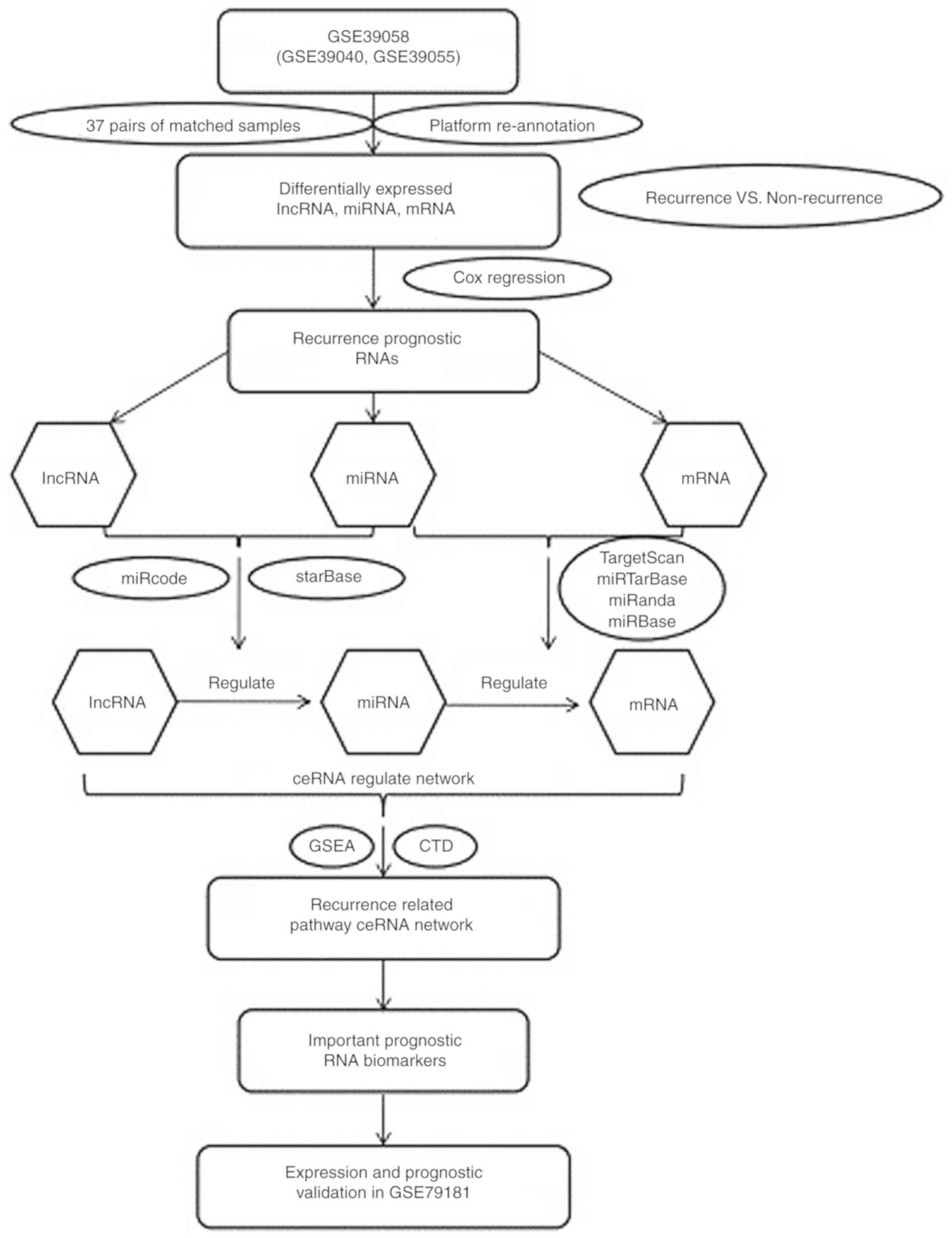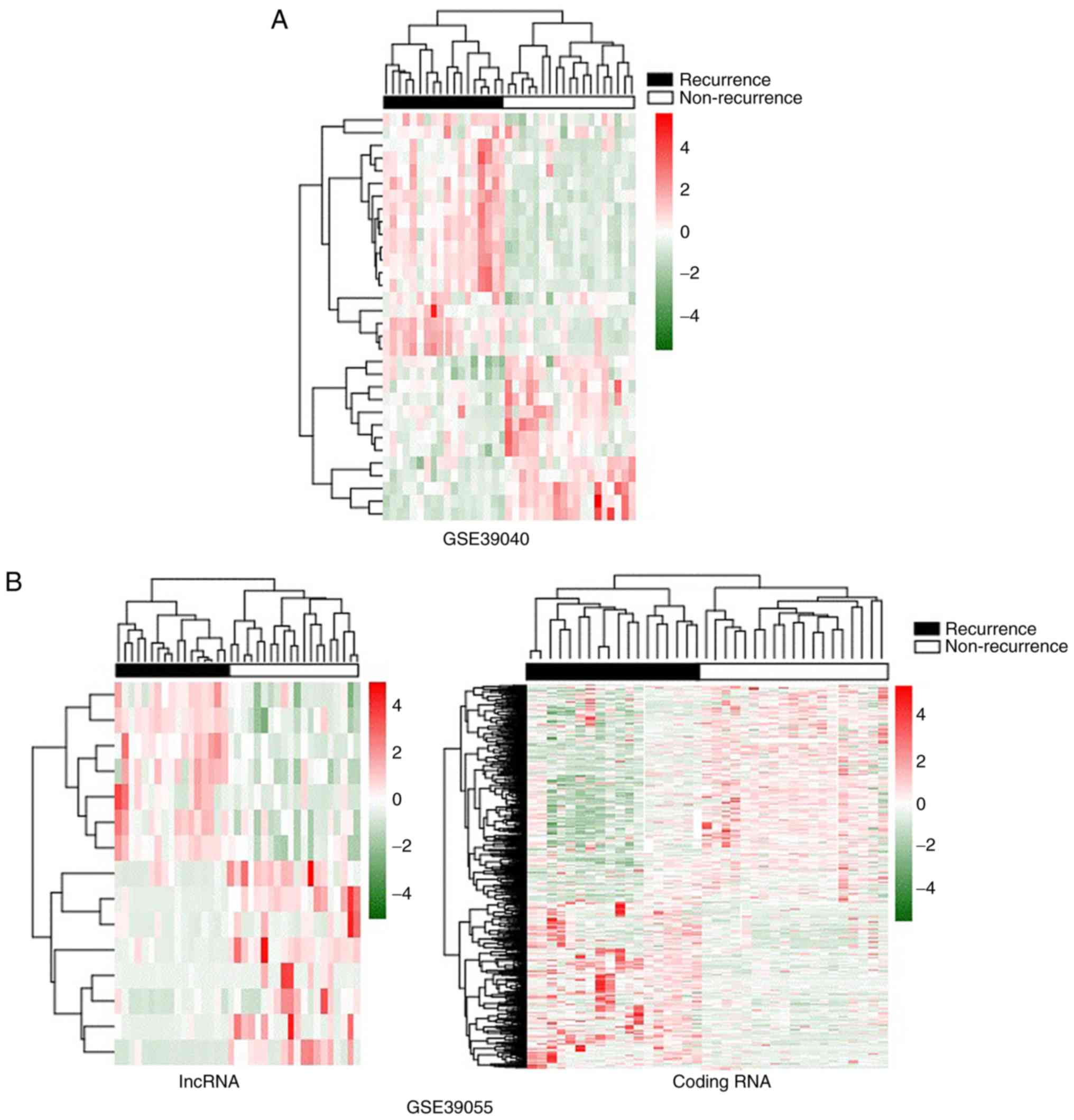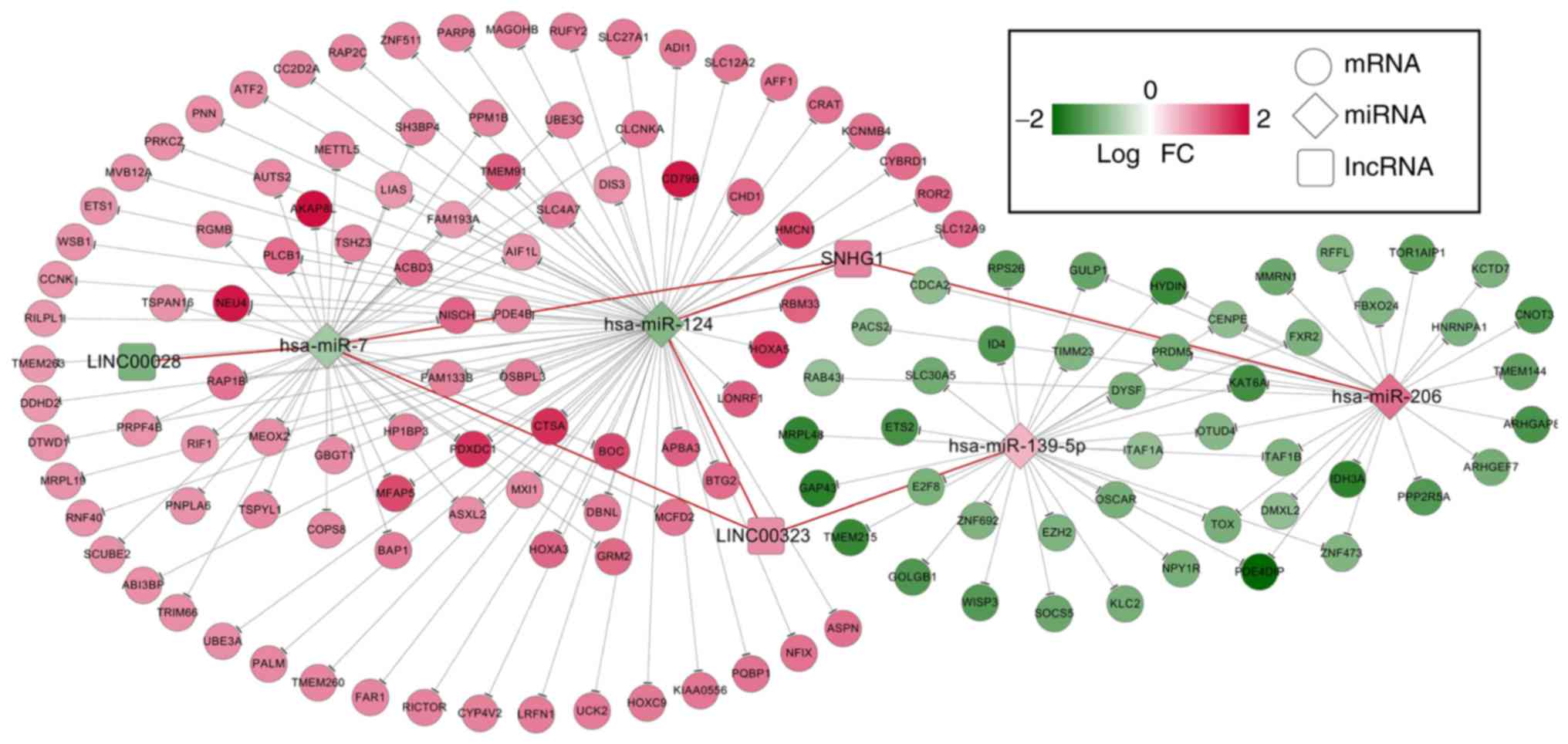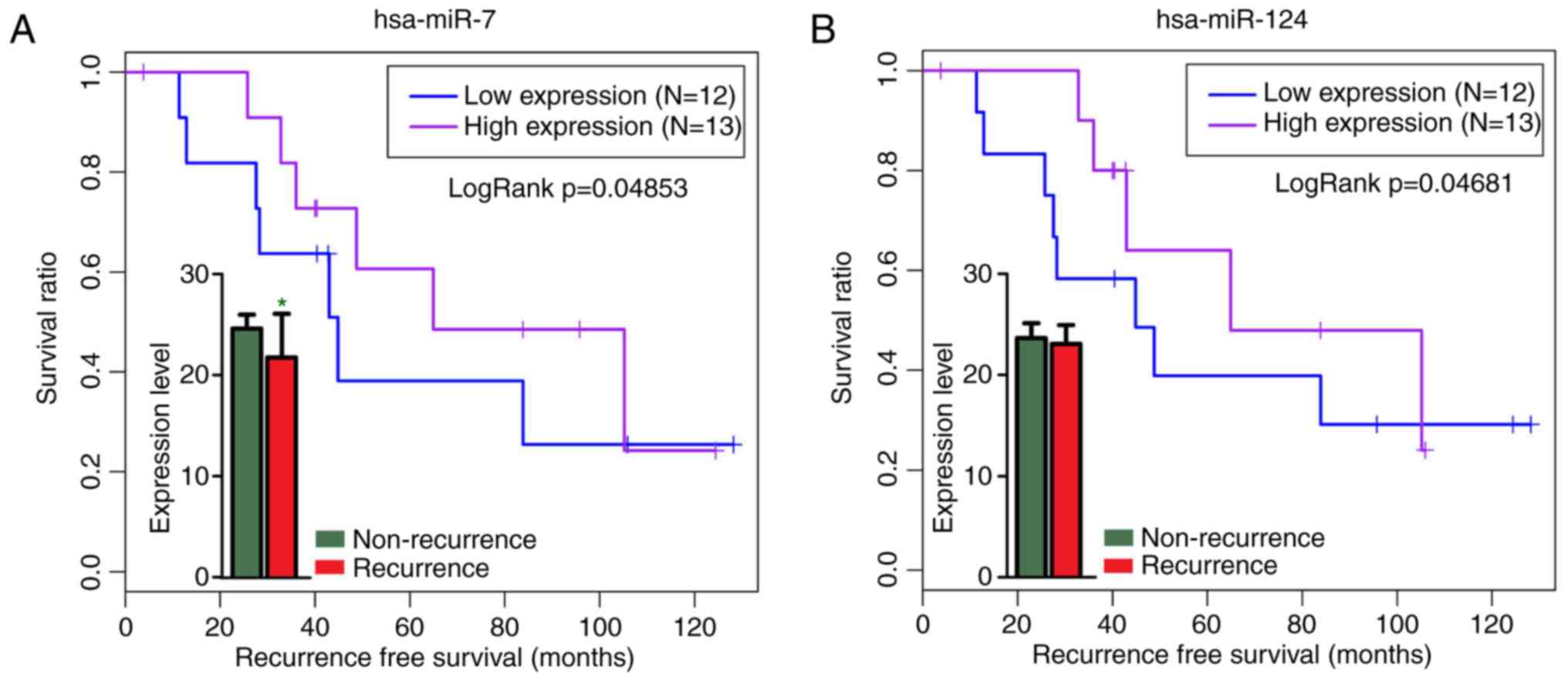Introduction
Osteosarcoma is the most common primary malignant
bone tumor and often exhibits locally invasive growth. Osteosarcoma
is commonly characterized by an appendicular primary tumor with a
high rate of pulmonary metastases (1). In addition, osteosarcoma is a
genetically unstable and highly malignant mesenchymal tumor of the
bone characterized by structural chromosomal alterations (2,3).
Improved understanding of the molecular mechanisms
underlying osteosarcoma would support the development of effective
and targeted therapies. Many previous studies have reported
molecular mechanisms underlying osteosarcoma that were involved in
the progression and metastasis of osteosarcoma (4-8).
Inhibiting Wnt/β-catenin signaling and targeting c-Met, a
Wnt-regulated proto-oncogene, have shown to be useful in the
treatment of osteosarcoma (4,5).
The Notch pathway has a vital role in regulating tumor angiogenesis
and vasculogenesis in osteosarcoma (6). Wilms' tumor gene 1 has been reported
to act as a tumor promoter in osteosarcoma by regulating cell cycle
and apoptotic machinery (7).
Recently, COP9 signalosome subunit 3 (COPS3), another oncogene
overexpressed in osteosarcoma, was revealed to be involved in
osteosarcoma metastasis by interacting with Beclin1 and Raf-1
through autophagy (8). In
addition, some studies have reported the roles of long non-coding
RNAs (lncRNAs) in the progression, metastasis, and prognosis of
osteosarcoma (9-16). A previous study also demonstrated
that lncRNAs may function as competing endogenous RNAs (ceRNAs) to
sponge microRNAs (miRNAs), thereby regulating miRNA targets
(17).
Hedgehog signaling in mature osteoblasts is
responsible for the pathogenesis of osteoblastic osteosarcoma
through the overexpression of yes-associated protein 1 and lncRNA
H19 (9). The lncRNA small
nucleolar RNA host gene 1 (SNHG12) could upregulate the expression
of Notch2 to promote osteosarcoma metastasis by acting as a sponge
of miR-195-5p (10). The lncRNA
focally amplified lncRNA on chromosome 1 has been shown to be a
negative prognostic biomarker and exhibit an important
pro-oncogenic effect on osteosarcoma progression by targeting
epithelial-mesenchymal transition (11). Decreased expression levels of the
lncRNA maternally expressed 3 (MEG3) has been reported to be an
independent predictor of shorter overall survival in patients with
osteosarcoma, suggesting that MEG3 lncRNA may be a useful biomarker
for the prognosis of osteosarcoma (12). In addition, lncRNA MEG3 could
promote osteosarcoma cell growth and metastasis in vitro by
acting as a sponge of miR-127 (13). In a two-stage and case-control
study of 900 osteosarcoma cases and 900 controls among the Chinese
population, those with the rs7958904 CC genotype had a
significantly lower expression level of the lncRNA HOX transcript
antisense RNA than those with other genotypes, as well as a lower
risk of osteosarcoma (14). The
upregulation of lncRNA taurine upregulated 1 was also revealed to
be strongly associated with poor prognosis and was an independent
prognostic indicator for overall progression-free survival in
osteosarcoma (15). Patients with
osteosarcoma and high expression levels of lncRNA HOXA distal
transcript antisense RNA had poorer overall survival than those
with low expression levels (16).
The majority of prognostic miRNAs were located at 14q32 in a study
by Kelly et al (18);
their gene targets displayed deregulation patterns associated with
outcomes based on their developed miRNA models, with independent
predictive values for recurrence and overall survival from
formalin-fixed, paraffin-embedded human osteosarcoma diagnostic
biopsy specimens. However, the roles of the lncRNAs were not
investigated. In the present study, the GSE3905 dataset was
downloaded to identify prognosis-associated RNAs for ceRNA
regulatory network construction. In addition, the important
pathways were determined using Gene Set Enrichment Analysis (GSEA).
Kaplan-Meier survival analysis was conducted to determine the
associations between the expression levels and survival prognosis.
Furthermore, another independent miRNA profile, GSE79181, was
downloaded from Gene Expression Omnibus (GEO) for validation
(Fig. 1).
Materials and methods
Microarray data and preprocessing
The expression profile of GSE39058 (18), containing two subdatasets
(GSE39040 and GSE39055), was downloaded from GEO (www.ncbi.nlm.nih.gov/geo/). The small non-coding
RNA (miRNA) profile of GSE39040, containing 65 human osteosarcoma
biopsy specimens, was generated using the platform GPL15762
(Illumina Human v2 MicroRNA Expression BeadChip; Illumina, Inc.,
San Diego, CA, USA) and the expression profile of GSE39055
containing 37 human osteosarcoma biopsy specimens was based on the
platform of GPL14951 (Illumina HumanHT-12 WG-DASL V4.0 R2
Expression BeadChip); Illumina, Inc.). The paired miRNA and mRNA
profiles of 37 biopsy specimens were used for further analysis. The
probe names in the gene expression profiles were converted into
gene names. In addition, the mean value of a gene symbol matched
with multiple probes was calculated using the function in R
software (version 3.4.1) (19).
Subsequently, the microarray data were normalized using the
preprocessCore package in R software (version 3.4.1) (19). The Linear Models for Microarray
Analysis (Limma) package (version 3.32.5) in R software (20) was used for log2 conversion and the
sequencing data were normalized using the quantile method (21).
Differential expression analysis and
hierarchical clustering
The mRNAs and lncRNAs in the GSE39055 dataset were
annotated using the Transcript ID, RefSeq ID and location,
supported by the GPL14951 (Illumina HumanHT-12 WG-DASL V4.0;
Illumina, Inc.) platform and HUGO Gene Nomenclature Committee
(www.genenames.org), which has 3,859 lncRNAs and
19,180 protein-coding genes (22). The 37 biopsy specimens of the
paired miRNA and mRNA profile were divided into recurrent (n=18)
and non-recurrent (n=19) osteosarcoma samples based on the clinical
information. The Limma package (20) was used to perform differential
expression analysis between recurrent and non-recurrent
osteosarcoma samples. The P-values were adjusted for false
discovery rate (FDR) using the Benjamini-Hochberg method (23). The thresholds for screening
differentially expressed mRNAs, miRNAs and lncRNA were set as
FDR<0.05 and |log2 fold-change (FC)|>0.585. In
addition, the expression values of screened differentially
expressed RNAs were hierarchically clustered using the pheatmap
package (version 1.0.8) (24) in
R based on the encyclopedia of distances (25) to observe the differences in
expression levels spontaneously.
Screening prognosis-associated RNAs
The expression levels of differentially expressed
RNAs and the prognostic information of each sample were collected.
The survival package (26) in R
was used to identify the prognosis-associated mRNAs, miRNAs and
lncRNAs by Cox regression univariate analysis, and P<0.05 was
used as the cut-off criterion. Subsequently, the Database for
Annotation, Visualization and Integrated Discovery (version 6.8)
(27) was used to perform Gene
Ontology (GO) functional [biology process (BP), molecular function
(MF) and cellular component (CC)] and Kyoto Encyclopedia of Genes
and Genomes (KEGG) pathway enrichment analysis for
prognosis-associated mRNAs, with a threshold of P<0.05.
ceRNA regulatory network construction and
analysis
The identified prognosis-associated lncRNAs and
miRNAs were used to select lncRNA-miRNA regulatory relationships
from the associations in miRcode (version 11; www.mircode.org/) and starBase (version 2.0;
starbase.sysu.edu.cn/index.php)
(28). In addition, the
miRNA-mRNA regulatory associations were selected based on the
regulatory information in TargetScan (release 7.1; www.targetscan.org/vert_71/) (29), miRTarBase (release 6.0; mirtarbase.mbc.nctu.edu.tw) (30), miRanda (version 2.0; www.microrna.org/microrna/home.do)
(31) and miRBase (release 21;
www.mirbase.org/) (32). The ceRNA regulatory network was
constructed by integrating the lncRNA-miRNA and miRNA-mRNA
regulatory relationships via Cytoscape (version 3.4; www.cytoscape.org/) (33).
The genes in the constructed ceRNA regulatory
network were used for GSEA (2017 update; software.broadinstitute.org/gsea/index.jsp) to
identify the important KEGG pathways (34). Subsequently, the KEGG pathways
directly associated with osteosarcoma were screened by searching
the term ‘osteosarcoma’ in the Comparative Toxicogenomics Database
(CTD; 2017 update; ctd.mdibl.org/) (35).
Validation of prognosis-associated
RNAs
The important RNAs participating in the KEGG
pathways directly associated with osteosarcoma were used to
classify the samples into high- and low-expression groups based on
the expression levels. Kaplan-Meier survival analysis, conducted
with R software (version 3.4.1), was used to determine the
associations between the expression levels and survival prognosis.
Another independent miRNA profile, GSE79181, containing 25
osteosarcoma samples was downloaded from GEO (www.ncbi.nlm.nih.gov/geo/) to validate the
reliability of the important molecules.
Results
DEGs screening and hierarchical
clustering
Following data preprocessing, 15 differentially
expressed lncRNAs (8 down-regulated and 7 upregulated lncRNAs) and
837 differentially expressed mRNAs (362 downregulated and 475
upregulated mRNAs) were identified in the GSE30955 profile. In
addition, 32 differentially expressed miRNAs, including 13
down-regulated and 19 upregulated miRNAs, were revealed in the
GSE39040 profile. The expression values of differentially expressed
miRNAs, lncRNAs, and mRNAs were hierarchically clustered, and the
color contrast indicated a significant difference in the expression
levels between the recurrent and non-recurrent osteosarcoma samples
(Fig. 2).
Prognosis-associated mRNAs, miRNAs and
lncRNAs
Among the selected differentially expressed RNAs,
417 RNAs (5 lncRNAs, 19 miRNAs and 393 mRNAs) were revealed to be
associated with prognosis. The functional enrichment analysis for
prognosis-associated mRNAs demonstrated that these 393 mRNAs were
markedly involved with 10, 8 and 2 GO terms in the BP, CC
and MF categories, respectively (Table I). These functions were mainly
associated with ‘chromatin organization’ and ‘transcription
regulator’. Furthermore, 9 KEGG pathways were enriched for
prognosis-associated mRNAs, such as ‘transforming growth factor-β
signaling pathway’ (P= 0.0258), ‘Wnt signaling pathway’ (P= 0.0366)
and ‘Oxidative phosphorylation’ (P=0.0493; Table II).
 | Table IGene Ontology functional enrichment
analysis in terms of biology process, cellular component and
molecular function for the prognosis-associated mRNAs. |
Table I
Gene Ontology functional enrichment
analysis in terms of biology process, cellular component and
molecular function for the prognosis-associated mRNAs.
| Category | Term | Count | P-Value | Genes |
|---|
| BP | GO:0043009~chordate
embryonic development | 16 | 0.0033 | MAFG, NBN, SYVN1,
ADA, HOXA2, HOXA3, HOXC9, MEOX2, HOXA5, HOXB8, NCOA6, APBA3, DAD1,
MAPK8IP3, ROR2, MED1 |
|
GO:0048568~embryonic organ
development | 10 | 0.0086 | HOXA2, HOXC9,
HOXA3, HOXB8, HOXA5, MYO7A, ROR2, VAX2, ADA, MED1 |
|
GO:0003002~regionalization | 10 | 0.0195 | HOXA2, HOXC9,
HOXA3, BTG2, MEOX2, HOXB8, HOXA5, ROR2, VAX2, LRP5 |
|
GO:0051276~chromosome organization | 18 | 0.0208 | MEAF6, NBN,
HIST1H1D, HIST1H2BF, HP1BP3, HIST1H1A, EZH2, CENPE, TSPYL1, CHMP1A,
EYA2, HDAC2, NCAPG, PRDM5, CHD1,TLK1, RNF40, KDM5D |
| GO:0001501~skeletal
system development | 13 | 0.0296 | ESRRA, AEBP1, BMP1,
TUFT1, ATP6V1B1, HOXA2, HOXA3, HOXC9, HOXB8, HOXA5, ETS2, COMP,
ROR2 |
|
GO:0006351~transcription,
DNA-dependent | 12 | 0.0367 | TAF11, TAF1B, MED7,
CCNK, TAF1A, ETS1, ANG, NCOA6, NFIX, POLR2D, MED1, TAF1L |
| GO:0032774~RNA
biosynthetic process | 12 | 0.0399 | TAF11, TAF1B, MED7,
CCNK, TAF1A, ETS1, ANG, NCOA6, NFIX, POLR2D, MED1, TAF1L |
| GO:0045597~positive
regulation of cell differentiation | 10 | 0.0448 | IKZF1, ETS1, VHL,
MAPT, KITLG, SEMA4D, SOCS5, NTN1, BOC, ADA |
|
GO:0006325~chromatin organization | 14 | 0.0458 | MEAF6, HIST1H1D,
HP1BP3, HIST1H2BF, HIST1H1A, EZH2, TSPYL1, EYA2, HDAC2, PRDM5,
CHD1, TLK1, RNF40, KDM5D |
|
GO:0048598~embryonic morphogenesis | 12 | 0.0495 | HOXA2, EYA2, HOXC9,
HOXA3, HOXB8, HOXA5, MYO7A, CRABP2, ROR2, VAX2, MED1, LRP5 |
| CC | GO:0044463~cell
projection part | 15 | 0.0002 | PLD2, BBS5, PARD3,
TTLL6, KLC2, GAS8, ADA, SPAG16, PCSK1, CC2D2A, CYBRD1, MAPK8IP3,
PEBP1, SLC5A6, CNTNAP1 |
| GO:0042995~cell
projection | 26 | 0.0017 | BBS5, PARD3, MYO7A,
CLSTN1, TTLL6, KLC2, ADA, SPAG16, PCSK1, ANG, MAPT, SLC4A7,
CNTNAP1, PLD2, DBNL, ARHGEF7, NPY1R, GAS8, THY1, GRM2, CC2D2A,
CYBRD1, PEBP1, MAPK8IP3, SLC5A6, GAP43 |
|
GO:0005694~chromosome | 19 | 0.0030 | TCP1, NBN,
HIST1H1D, PRPF4B, IKZF1, HIST1H2BF, PPP2R5A, HP1BP3, HIST1H1A,
AKAP8L, CENPE, TRIM66, CHMP1A, HDAC2, RIF1, NCAPG, PPP2CB, CHD1,
RNF40 |
|
GO:0044427~chromosomal part | 15 | 0.0158 | TCP1, NBN,
HIST1H1D, IKZF1, HIST1H2BF, HP1BP3, PPP2R5A, HIST1H1A, CENPE,
TRIM66,HDAC2, RIF1, NCAPG, PPP2CB, CHD1 |
|
GO:0005578~proteinaceous extracellular
matrix | 13 | 0.0195 | ASPN, COL4A2,
HMCN1, ADAMTSL2, LAMC3, ANG, FBLN2, COMP, TIMP4, MMP3, NTN1, MFAP5,
SPON1 |
| GO:0043005~neuron
projection | 13 | 0.0306 | ARHGEF7, NPY1R,
KLC2, ADA, THY1, PCSK1, GRM2, ANG, MAPT, MAPK8IP3, PEBP1, CNTNAP1,
GAP43 |
|
GO:0031012~extracellular matrix | 13 | 0.0322 | ASPN, COL4A2,
HMCN1, ADAMTSL2, LAMC3, ANG, FBLN2, COMP, TIMP4, MMP3, NTN1, MFAP5,
SPON1 |
|
GO:0005730~nucleolus | 21 | 0.0440 | UTP23, MEAF6,
PNMA3, NBN, SYVN1, TAF1A, TSR1, HNRNPA1, PNN, TSPYL1, NOP14, STAT6,
DIS3, KRT17, ANG, RPL9, NCOA6, PQBP1, LIAS, HNRNPH1, ARL4A |
| MF |
GO:0043565~sequence-specific DNA
binding | 22 | 0.0116 | MAFG, TSHZ3, ERF,
ESRRA, IKZF1, TFE3, VAX2, NFIX, ATF2, STAT6, ATF5, HOXA2, HDAC2,
HOXA3, HOXC9, MEOX2, HOXA5, ETS1, HOXB8, ETS2, PRDM5, CREB3L4 |
|
GO:0030528~transcription regulator
activity | 41 | 0.0440 | TAF1B, TSHZ3,
AEBP1, TAF1A, TFE3, E2F8, EZH2, CNOT3, NFIX, MXI1, ATF2, ZNF75D,
KCNIP3, STAT6, TRIM66, HOXA2, HOXC9, HOXA3, HOXA5, PQBP1, CREB3L4,
TAF1L, MAFG, ERF, ESRRA, IKZF1, VAX2, AFF1, MSRB2, TAF11, MED7,
ATF5, HDAC2, MEOX2, ETS1, HOXB8, ETS2, PRDM5, NCOA6, ID4, MED1 |
 | Table IINine enriched Kyoto Encyclopedia of
Genes and Genomes pathways for prognosis-associated mRNAs. |
Table II
Nine enriched Kyoto Encyclopedia of
Genes and Genomes pathways for prognosis-associated mRNAs.
| KEGG Pathway | Count | P-Value | Genes |
|---|
| hsa00520:Amino
sugar and nucleotide sugar metabolism | 3 | 0.0224 | GMPPB, PGM3,
FUK |
|
hsa00603:Glycosphingolipid
biosynthesis | 2 | 0.0249 | GBGT1,
B3GALNT1 |
| hsa04350:TGF-β
signaling pathway | 4 | 0.0258 | AMHR2, COMP,
PPP2CB, ID4 |
|
hsa04144:Endocytosis | 6 | 0.0316 | PRKCZ, PLD2, PARD3,
RAB11FIP3, ACAP2, AGAP1 |
| hsa04310:Wnt
signaling pathway | 5 | 0.0366 | PPP2R5A, PPP2CB,
PRICKLE2, PLCB1, LRP5 |
| hsa03020:RNA
polymerase | 2 | 0.0437 | POLR2D,
POLR2J2 |
|
hsa04070:Phosphatidylinositol signaling
system | 3 | 0.0445 | DGKQ, PLCD4,
PLCB1 |
|
hsa03040:Spliceosome | 4 | 0.0473 | PQBP1, MAGOHB,
THOC2, HNRNPA1 |
| hsa00190:Oxidative
phosphorylation | 4 | 0.0493 | NDUFB4, ATP6V1E2,
ATP6V1B1, COX17 |
ceRNA regulatory network construction and
analysis
A total of 65 lncRNA-miRNA regulatory relationships
associated with the 5 prognosis-associated lncRNAs were identified
in miRcode and starBase. In addition, 7 lncRNA-miRNA regulatory
relationships associated with the 19 prognosis-associated miRNAs
were further screened, which involved three lncRNAs [long
intergenic non-protein coding RNA 28 (LINC00028), LINC00323 and
SNHG1] and four miRNAs (hsa-miR-124, hsa-miR-139-5p, hsa-miR-7, and
hsa-miR-206). Furthermore, 172 miRNA-mRNA regulatory relationships
were obtained for these four miRNAs using TargetScan, miRBase,
miRanda, and miRTarBase. Finally, the 7 lncRNA-miRNA and 172
miRNA-mRNA regulatory relationships were used to construct the
ceRNA regulatory network, which included 3 lncRNAs, 4 miRNAs and
143 mRNAs (Fig. 3).
The GSEA for the ceRNA regulatory network revealed
that three KEGG pathways [‘Mitogen-activated protein kinase (MAPK)
signaling pathway’, ‘Chemokine signaling pathway’ and
‘Spliceosome’] were markedly associated with osteosarcoma (Table III). Furthermore, ‘MAPK
signaling pathway’ involving three genes [Ras-related protein
Rap-1b (RAP1B), activating transcription factor 2 (ATF2) and
protein phosphatase Mg2+/Mn2+ dependent 1B
(PPM1B)] was also demonstrated to be associated with osteosarcoma
by searching the CTD. Based on the ceRNA regulatory network, two
miRNAs (hsa-miR-124 and hsa-miR-7) and three lncRNAs (LINC00028,
LINC00323, and SNHG1) could regulate the three mRNAs (RAP1B, ATF2,
and PPM1B) that participate in the MAPK signaling pathway (Fig. 4).
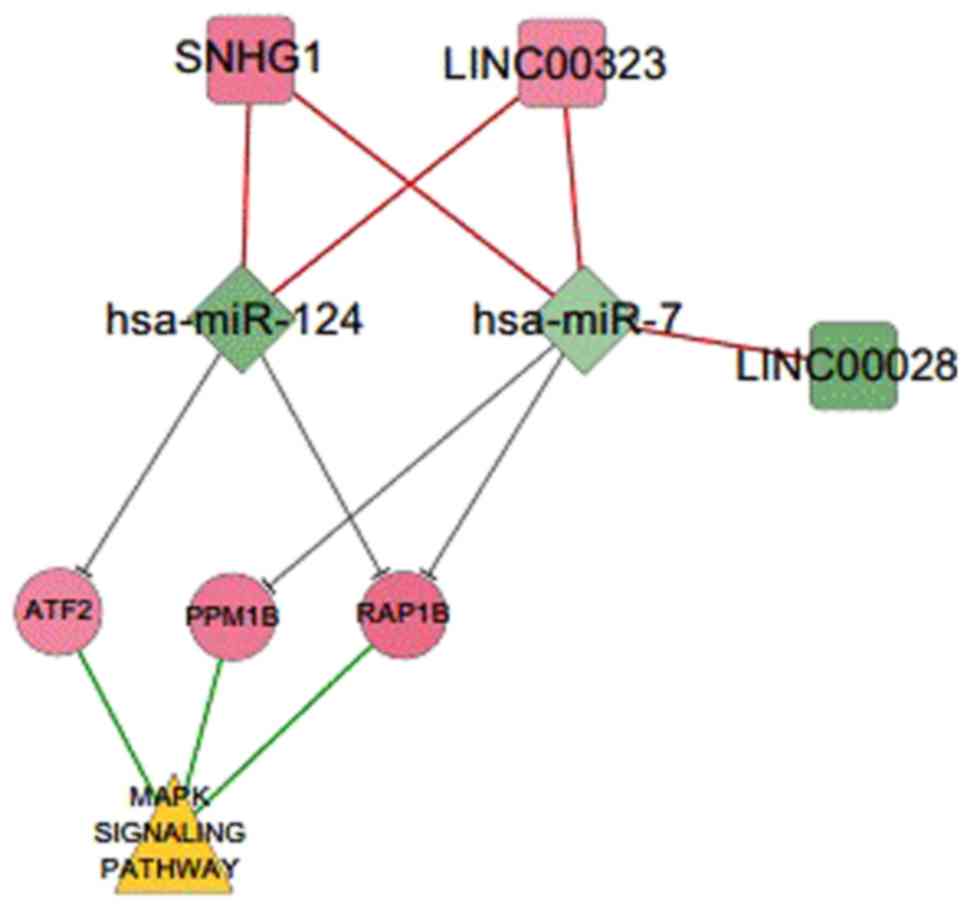 | Figure 4ceRNA regulatory network associated
with the MAPK signaling pathway. Two miRNAs (hsa-miR-124 and
hsa-miR-7) and three lncRNAs (LINC00028, LINC00323, and SNHG1)
could regulate three mRNAs (RAP1B, ATF2 and PPM1B) that participate
in the MAPK signaling pathway. lncRNA, long non-coding RNA;
miRNA/miR, microRNA; ceRNA, competing endogenous RNA; LINC, long
intergenic non-protein coding RNA; SNHG1, small nucleolar RNA host
gene 1; RAP1B, Ras-related protein Rap-1b; ATF2, activating
transcription factor 2; PPM1B, protein phosphatase
Mg2+/Mn2+ dependent 1B; MAPK,
mitogen-activated protein kinase. |
 | Table IIIGene Set Enrichment Analysis for the
competing endogenous RNA regulatory network. |
Table III
Gene Set Enrichment Analysis for the
competing endogenous RNA regulatory network.
| Name | Enrichment
score | Normalized
enrichment score | Nominal
P-value | Genes |
|---|
|
MAPK_SIGNALING_PATHWAY | 0.5145 | 1.1238 | 0.0324 | RAP1B, ATF2,
PPM1B |
|
CHEMOKINE_SIGNALING_PATHWAY | 0.4710 | 1.0218 | 0.0423 | RAP1B, PLCB1,
PRKCZ |
| SPLICEOSOME | 0.3188 | 0.6929 | 0.0485 | MAGOHB, PQBP1 |
Validation of prognosis-associated
RNAs
The samples were classified into high- and
low-expression groups based on the expression levels of three mRNAs
(RAP1B, ATF2, and PPM1B), two miRNAs (hsa-miR-124 and hsa-miR-7),
and three lncRNAs (LINC00028, LINC00323, and SNHG1). Kaplan-Meier
survival analysis revealed that samples with lower expression
levels of LINC00323 and SNHG1 had better prognosis, and increased
expression levels of LINC00028, hsa-miR-124, and hsa-miR-7 were
associated with better prognosis. The overexpression of RAP1B, ATF2
and PPM1B was also positively associated with osteosarcoma
recurrence (Fig. 5).
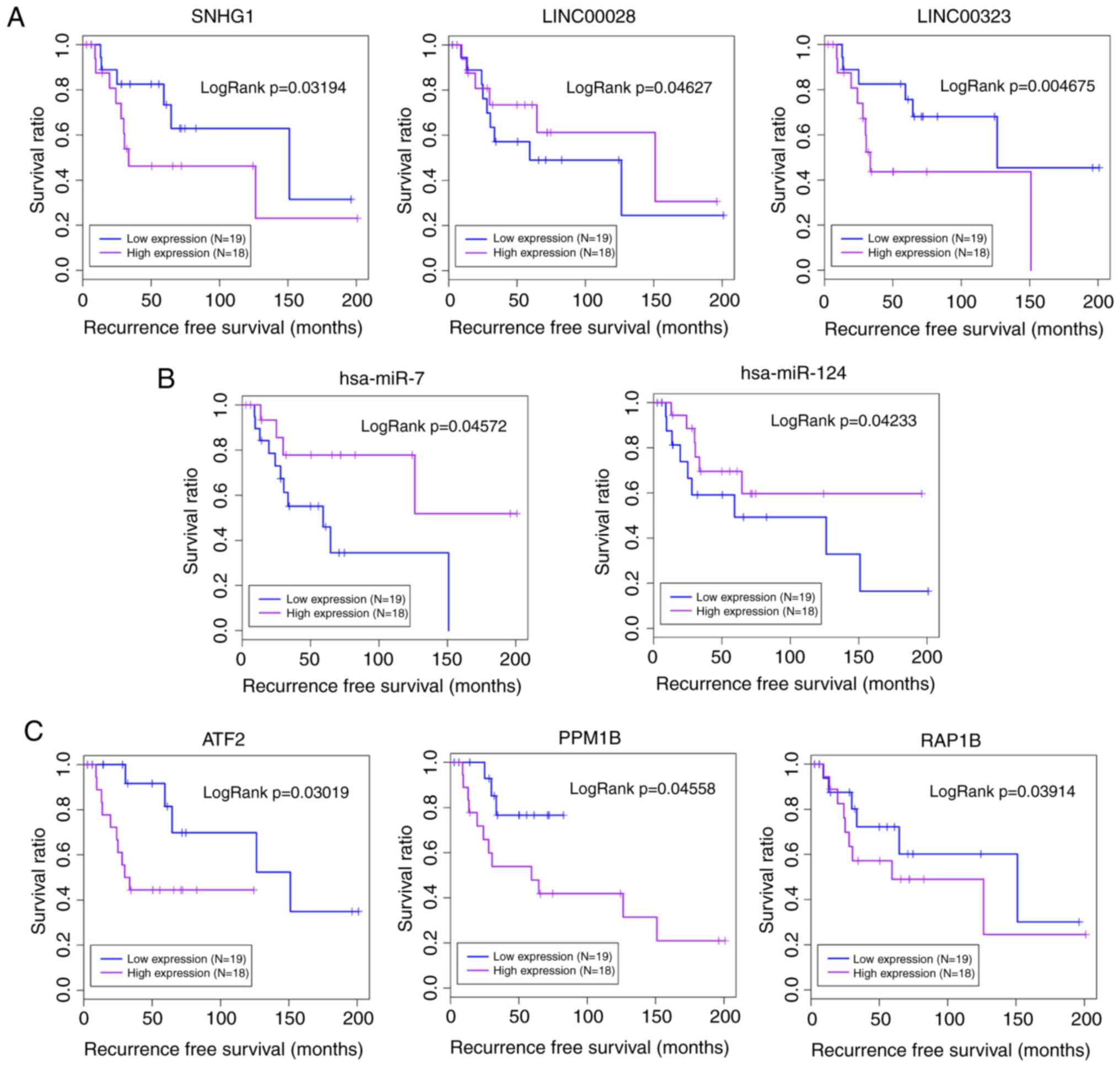 | Figure 5Kaplan-Meier survival analysis for
lncRNAs, miRNAs and mRNAs associated with the mitogen-activated
protein kinase signaling pathway. (A) Lower expression levels of
LINC00323 and SNHG1, and increased expression levels of LINC00028
were associated with better prognosis. (B) Samples with increased
expression levels of hsa-miR-124 and hsa-miR-7 had better
prognosis. (C) The overexpression of RAP1B, ATF2, and PPM1B was
positively associated with osteosarcoma recurrence. lncRNA, long
non-coding RNA; miRNA/miR, microRNA; ceRNA, competing endogenous
RNA; LINC, long intergenic non-protein coding RNA; SNHG1, small
nucleolar RNA host gene 1; RAP1B, Ras-related protein Rap-1b; ATF2,
activating transcription factor 2; PPM1B, protein phosphatase
Mg2+/Mn2+ dependent 1B. |
The expression level of hsa-miR-7 was significantly
down-regulated in the osteosarcoma recurrent samples (P=0.02346) of
another independent miRNA profile, GSE79181 (Fig. 6A). Kaplan-Meier survival analysis
revealed that hsa-miR-124 (P=0.04681) and hsa-miR-7 (P=0.04853)
were markedly associated with osteosarcoma recurrence (Fig. 6) using GSE79181. These results
were in accordance with the GSE39040 analysis results.
Discussion
Understanding the mechanisms underlying osteosarcoma
pathogenesis is necessary to determine novel biomarkers for the
development of novel treatment strategies, particularly for
metastases, as the prognosis of osteosarcoma is still poor
(36). A number of previous
studies have suggested that the dysregulated expression of lncRNAs
could independently predict the outcomes of patients with
osteosarcoma (37,38). In the present study, 417 RNAs (5
lncRNAs, 19 miRNAs and 393 mRNAs) were revealed to be associated
with prognosis among the total number of differentially expressed
RNAs identified. Subsequently, the prognosis-associated RNAs were
used to construct a ceRNA regulatory network for GSEA. The GSEA for
the ceRNA regulatory network revealed that ‘MAPK signaling
pathway’, ‘Chemokine signaling pathway’ and ‘Spliceosome’ were
markedly associated with osteosarcoma. In addition, the MAPK
signaling pathway was also demonstrated to be associated with
osteosarcoma via the CTD.
MAPK is an insulin-mitogen activated protein
(Ser/Thr) kinase, and activated MAPK can transmit extracellular
signals to regulate cell growth, migration and apoptosis (39). Many studies have reported the
significant roles of the MAPK signaling pathway in osteosarcoma
(40,41). The expression level of S100
calcium binding protein A9 (S100A9) was increased in human
osteosarcoma tissues and associated with survival rate, and the
downregulation of S100A9 inhibited osteosarcoma cell proliferation
through the inactivation of the MAPK and NF-κB signaling pathways
(42). Increased expression
levels of phospholipase A2 group XVI could enhance osteosarcoma
metastasis by activating the MAPK signaling pathway (43). Delphinidin treatment could inhibit
cell migration and prevented epithelial-to-mesenchymal transition
via the MAPK signaling pathway in osteosarcoma cell lines (44). Onzin overexpression could also
contribute to more aggressive osteosarcoma metastatic phenotypes
through the C-X-C motif chemokine 5-MAPK signaling pathway
(45).
In the constructed ceRNA regulatory network, three
lncRNAs (LINC00028, LINC00323 and SNHG1) and two miRNAs
(hsa-miR-124 and hsa-miR-7) regulating three mRNAs (RAP1B, ATF2 and
PPM1B) participated in the MAPK signaling pathway. In addition,
samples with increased expression levels of hsa-miR-124 and
hsa-miR-7 had better prognosis. Expression levels of miR-124 in the
metastatic osteosarcoma tissues were revealed to be significantly
lower than those observed in non-metastatic tissues, and miR-124
could function as a tumor suppressor miRNA in osteosarcoma through
the inhibition of Rac family small guanosine triphosphatase 1
expression (46). In addition,
miR-7 expression was decreased in osteosar-coma tissues and low
miR-7 expression was associated with poor prognosis (47). Furthermore, the roles of
hsa-miR-124 and hsa-miR-7 in osteosarcoma recurrence were also
validated using another independent miRNA profile in the present
study.
Kaplan-Meier survival analysis revealed that samples
with lower expression levels of LINC00323 and SNHG1 had better
prognosis, which were consistent with a study by Wang et al
(48), which demonstrated that
SNHG1 was upregulated in osteosarcoma tissues and cell lines, and
high SNHG1 expression predicted poor overall survival in patients
with osteosarcoma; these findings were consistent with the present
results. Wang et al (48)
reported that SNHG1 increased human nin one binding protein (an
oncogene) by acting as a ceRNA to sponge miR-326, promoting cell
growth, migration and invasion in osteosarcoma, while the present
study revealed that SNHG1 increased ATF2, PPM1B and RAP1B by
sponging miR-124 and miR-7 as a ceRNA. In addition, high SNHG1
expression was also positively associated with the metastasis of
osteosarcoma, and miR-577 could act as a ceRNA of SNHG1 by
targeting WNT2B which served an oncogenic role in osteosarcoma
cells by activating the Wnt/β-catenin signaling pathway (49). Therefore, the present study showed
that the SNHG1/miR-124 and miR-7/RAP1B, ATF2 and PPM1B/MAPK
signaling pathway regulatory network may provide a potential novel
therapeutic strategy for osteosarcoma treatment.
In conclusion, three lncRNAs (LINC00028, LINC00323
and SNHG1) and two miRNAs (hsa-miR-124 and hsa-miR-7) regulating
three mRNAs (RAP1B, ATF2 and PPM1B) participated in MAPK signaling
pathway, as identified by the ceRNA regulatory network, and were
associated with osteosarcoma recurrence. However, the prognosis
prediction value based on the expressions of these important RNAs
still requires further confirmation based on clinical experiments
in an independent cohort of patients with non-recurrent and
recurrent osteosarcoma.
Funding
No funding was received.
Availability of data and materials
The datasets used and/or analyzed during the present
study are available from the corresponding author on reasonable
request.
Authors' contributions
SZ and HF contributed to the study design. SZ, LD,
XL and HF searched for and downloaded the gene expression profiles
from the Gene Expression Omnibus database. SZ, LD, XL and HF
performed the analysis and interpretation of the microarray
dataset. SZ and HF critically revised the manuscript for important
intellectual content. All authors read and approved the final
manuscript.
Ethics approval and consent to
participate
Not applicable.
Patient consent for publication
Not applicable.
Competing interests
The authors declare that they have no competing
interests.
Acknowledgments
Not applicable.
References
|
1
|
Geller DS and Gorlick R: Osteosarcoma: A
review of diagnosis, management, and treatment strategies. Clin Adv
Hematol Oncol. 8:705–718. 2010.
|
|
2
|
He H, Ni J and Huang J: Molecular
mechanisms of chemoresistance in osteosarcoma (Review). Oncol Lett.
7:1352–1362. 2014. View Article : Google Scholar : PubMed/NCBI
|
|
3
|
Liu JJ, Liu S, Wang JG, Zhu W, Hua YQ, Sun
W and Cai ZD: Telangiectatic osteosarcoma: A review of literature.
Onco Targets Ther. 6:593–602. 2013.PubMed/NCBI
|
|
4
|
McQueen P, Ghaffar S, Guo Y, Rubin EM, Zi
X and Hoang BH: The Wnt signaling pathway: Implications for therapy
in osteosarcoma. Expert Rev Anticancer Ther. 11:1223–1232. 2011.
View Article : Google Scholar : PubMed/NCBI
|
|
5
|
Lin CH, Ji T, Chen CF and Hoang BH: Wnt
signaling in osteosarcoma. Adv Exp Med Biol. 804:33–45. 2014.
View Article : Google Scholar : PubMed/NCBI
|
|
6
|
McManus MM, Weiss KR and Hughes DP:
Understanding the role of Notch in osteosarcoma. Adv Exp Med Biol.
804:67–92. 2014. View Article : Google Scholar : PubMed/NCBI
|
|
7
|
Graziano AC, Cardile V, Avola R, Vicario
N, Parenti C, Salvatorelli L, Magro G and Parenti R: Wilms' tumor
gene 1 silencing inhibits proliferation of human osteosarcoma MG-63
cell line by cell cycle arrest and apoptosis activation.
Oncotarget. 8:13917–13931. 2017. View Article : Google Scholar : PubMed/NCBI
|
|
8
|
Zhang F, Yan T, Guo W, Sun K, Wang S, Bao
X, Liu K, Zheng B, Zhang H and Ren T: Novel oncogene COPS3
interacts with beclin1 and Raf-1 to regulate metastasis of
osteosarcoma through autophagy. J Exp Clin Cancer Res. 37:1352018.
View Article : Google Scholar : PubMed/NCBI
|
|
9
|
Chan LH, Wang W, Yeung W, Deng Y, Yuan P
and Mak KK: Hedgehog signaling induces osteosarcoma development
through Yap1 and H19 overexpression. Oncogene. 33:4857–4866. 2014.
View Article : Google Scholar
|
|
10
|
Zhou S, Yu L, Xiong M and Dai G: LncRNA
SNHG12 promotes tumorigenesis and metastasis in osteosarcoma by
upregulating Notch2 by sponging miR-195-5p. Biochem Biophys Res
Commun. 495:1822–1832. 2018. View Article : Google Scholar
|
|
11
|
Wang Y, Zhao Z, Zhang S, Li Z, Li D, Yang
S, Zhang H, Zeng X and Liu J: LncRNA FAL1 is a negative prognostic
biomarker and exhibits pro-oncogenic function in osteosarcoma. J
Cell Biochem. 119:8481–8489. 2018. View Article : Google Scholar : PubMed/NCBI
|
|
12
|
Tian ZZ, Guo XJ, Zhao YM and Fang Y:
Decreased expression of long non-coding RNA MEG3 acts as a
potential predictor biomarker in progression and poor prognosis of
osteosarcoma. Int J Clin Exp Pathol. 8:15138–15142. 2015.
|
|
13
|
Wang Y and Kong D: Knockdown of lncRNA
MEG3 inhibits viability, migration, and invasion and promotes
apoptosis by sponging miR-127 in osteosarcoma cell. J Cell Biochem.
119:669–679. 2018. View Article : Google Scholar
|
|
14
|
Zhou Q, Chen F, Fei Z, Zhao J, Liang Y,
Pan W, Liu X and Zheng D: Genetic variants of lncRNA HOTAIR
contribute to the risk of osteosarcoma. Oncotarget. 7:19928–19934.
2016.PubMed/NCBI
|
|
15
|
Ma B, Li M, Zhang L, Huang M, Lei JB, Fu
GH, Liu CX, Lai QW, Chen QQ and Wang YL: Upregulation of long
non-coding RNA TUG1 correlates with poor prognosis and disease
status in osteosarcoma. Tumour Biol. 37:4445–4455. 2016. View Article : Google Scholar
|
|
16
|
Li F, Cao L, Hang D, Wang F and Wang Q:
Long non-coding RNA HOTTIP is up-regulated and associated with poor
prognosis in patients with osteosarcoma. Int J Clin Exp Pathol.
8:11414–11420. 2015.PubMed/NCBI
|
|
17
|
Salmena L, Poliseno L, Tay Y, Kats L and
Pandolfi PP: A ceRNA hypothesis: The rosetta stone of a hidden RNA
language. Cell. 146:353–358. 2011. View Article : Google Scholar : PubMed/NCBI
|
|
18
|
Kelly AD, Haibe-Kains B, Janeway KA, Hill
KE, Howe E, Goldsmith J, Kurek K, Perez-Atayde AR, Francoeur N, Fan
JB, et al: MicroRNA paraffin-based studies in osteosarcoma reveal
reproducible independent prognostic profiles at 14q32. Genome Med.
5:22013. View
Article : Google Scholar : PubMed/NCBI
|
|
19
|
Bolstad B: PreprocessCore: A collection of
pre-processing functions. R package version 1. 2013.
|
|
20
|
Smyth GK: Limma: Linear models for
microarray data Bioinformatics computational biology Solutions
Using R Bioconductor. Springer; pp. 397–420. 2005
|
|
21
|
Rao Y, Lee Y, Jarjoura D, Ruppert AS, Liu
CG, Hsu JC and Hagan JP: A comparison of normalization techniques
for microRNA microarray data. Stat Appl Genet Mol Biol.
7:Article222008. View Article : Google Scholar : PubMed/NCBI
|
|
22
|
Yates B, Braschi B, Gray KA, Seal RL,
Tweedie S and Bruford EA: http://Genenames.orgurisimpleGenenames.org: The HGNC
and VGNC resources in 2017. Nucleic Acids Res. 45:D619–D625. 2017.
View Article : Google Scholar
|
|
23
|
Benjamini Y and Hochberg Y: Controlling
the false discovery rate: A practical and powerful approach to
multiple testing. J Royal Stat Soc Series B. 57:289–300. 1995.
|
|
24
|
Wang L, Cao C, Ma Q, Zeng Q, Wang H, Cheng
Z, Zhu G, Qi J, Ma H, Nian H and Wang Y: RNA-seq analyses of
multiple meristems of soybean: Novel and alternative transcripts,
evolutionary and functional implications. BMC Plant Biol.
14:1692014. View Article : Google Scholar : PubMed/NCBI
|
|
25
|
Gosling C: Encyclopedia of distances.
Reference Rev. 24:1–583. 2009.
|
|
26
|
Wang P, Wang Y, Hang B, Zou X and Mao JH:
A novel gene expression-based prognostic scoring system to predict
survival in gastric cancer. Oncotarget. 7:55343–55351.
2016.PubMed/NCBI
|
|
27
|
Huang Da W, Sherman BT and Lempicki RA:
Systematic and integrative analysis of large gene lists using DAVID
bioinformatics resources. Nature Protoc. 4:44–57. 2009. View Article : Google Scholar
|
|
28
|
Li JH, Liu S, Zhou H, Qu LH and Yang JH:
starBase v2.0: Decoding miRNA-ceRNA, miRNA-ncRNA and protein-RNA
interaction networks from large-scale CLIP-Seq data. Nucleic Acids
Res. 42:D92–D97. 2014. View Article : Google Scholar
|
|
29
|
Agarwal V, Bell GW, Nam JW and Bartel DP:
Predicting effective microRNA target sites in mammalian mRNAs.
Elife. 12:42015.
|
|
30
|
Lee YY, Kim TJ, Kim JY, Choi CH, Do IG,
Song SY, Sohn I, Jung SH, Bae DS, Lee JW and Kim BG: Genetic
profiling to predict recurrence of early cervical cancer. Gynecol
Oncol. 131:650–654. 2013. View Article : Google Scholar : PubMed/NCBI
|
|
31
|
Jeggari A, Marks DS and Larsson E:
miRcode: A map of putative microRNA target sites in the long
non-coding transcriptome. Bioinformatics. 28:2062–2063. 2012.
View Article : Google Scholar : PubMed/NCBI
|
|
32
|
Kozomara A and Griffiths-Jones S: miRBase:
Annotating high confidence microRNAs using deep sequencing data.
Nucleic Acids Res. 42:D68–D73. 2014. View Article : Google Scholar :
|
|
33
|
Shannon P, Markiel A, Ozier O, Baliga NS,
Wang JT, Ramage D, Amin N, Schwikowski B and Ideker T: Cytoscape: A
software environment for integrated models of biomolecular
interaction networks. Genome Res. 13:2498–2504. 2003. View Article : Google Scholar : PubMed/NCBI
|
|
34
|
Subramanian A, Tamayo P, Mootha VK,
Mukherjee S, Ebert BL, Gillette MA, Paulovich A, Pomeroy SL, Golub
TR, Lander ES and Mesirov JP: Gene set enrichment analysis: A
knowledge-based approach for interpreting genome-wide expression
profiles. Proc Natl Acad Sci USA. 102:15545–15550. 2005. View Article : Google Scholar : PubMed/NCBI
|
|
35
|
Davis AP, Grondin CJ, Johnson RJ, Sciaky
D, King BL, McMorran R, Wiegers J, Wiegers TC and Mattingly CJ: The
comparative toxicogenomics database: Update 2017. Nucleic Acids
Res. 45:D972–D978. 2017. View Article : Google Scholar :
|
|
36
|
He JP, Hao Y, Wang XL, Yang XJ, Shao JF,
Guo FJ and Feng JX: Review of the molecular pathogenesis of
osteosarcoma. Asian Pac J Cancer Prev. 15:5967–5976. 2014.
View Article : Google Scholar : PubMed/NCBI
|
|
37
|
Wang B, Su Y, Yang Q, Lv D, Zhang W, Tang
K, Wang H, Zhang R and Liu Y: Overexpression of long non-coding RNA
HOTAIR promotes tumor growth and metastasis in human osteosarcoma.
Mol Cells. 38:432–440. 2015. View Article : Google Scholar : PubMed/NCBI
|
|
38
|
Zhang Q, Geng PL, Yin P, Wang XL, Jia JP
and Yao J: Down-regulation of long non-coding RNA TUG1 inhibits
osteo-sarcoma cell proliferation and promotes apoptosis. Asian Pac
J Cancer Prev. 14:2311–2325. 2013. View Article : Google Scholar
|
|
39
|
Sui X, Kong N, Ye L, Han W, Zhou J, Zhang
Q, He C and Pan H: p38 and JNK MAPK pathways control the balance of
apoptosis and autophagy in response to chemotherapeutic agents.
Cancer Lett. 344:174–179. 2014. View Article : Google Scholar
|
|
40
|
Chen HJ, Lin CM, Lee CY, Shih NC, Peng SF,
Tsuzuki M, Amagaya S, Huang WW and Yang JS: Kaempferol suppresses
cell metastasis via inhibition of the ERK-p38-JNK and AP-1
signaling pathways in U-2 OS human osteosarcoma cells. Oncol Rep.
30:925–932. 2013. View Article : Google Scholar : PubMed/NCBI
|
|
41
|
Cheng DD, Zhu B, Li SJ, Yuan T, Yang QC
and Fan CY: Down-regulation of RPS9 inhibits osteosarcoma cell
growth through inactivation of MAPK signaling pathway. J Cancer.
8:2720–2728. 2017. View Article : Google Scholar : PubMed/NCBI
|
|
42
|
Cheng S, Zhang X, Huang N, Qiu Q, Jin Y
and Jiang D: Down-regulation of S100A9 inhibits osteosarcoma cell
growth through inactivating MAPK and NF-κB signaling pathways. BMC
Cancer. 16:2532016. View Article : Google Scholar
|
|
43
|
Li L, Liang S, Wasylishen AR, Zhang Y,
Yang X, Zhou B, Shan L, Han X, Mu T, Wang G and Xiong S: PLA2G16
promotes osteosarcoma metastasis and drug resistance via the MAPK
pathway. Oncotarget. 7:18021–18035. 2016.PubMed/NCBI
|
|
44
|
Kang HM, Park BS, Kang HK, Park HR, Yu SB
and Kim IR: Delphinidin induces apoptosis and inhibits
epithelial-to-mesenchymal transition via the ERK/p38 MAPK-signaling
pathway in human osteosarcoma cell lines. Environ Toxicol.
33:640–649. 2018. View Article : Google Scholar : PubMed/NCBI
|
|
45
|
Zhang Y, Hu Q, Li G, Li L, Liang S, Zhang
Y, Liu J, Fan Z, Li L, Zhou B, et al: ONZIN upregulation by mutant
p53 contributes to osteosarcoma metastasis through the CXCL5-MAPK
signaling pathway. Cell Physiol Biochem. 48:1099–1111. 2018.
View Article : Google Scholar : PubMed/NCBI
|
|
46
|
Geng S, Zhang X, Chen J, Liu X, Zhang H,
Xu X, Ma Y, Li B, Zhang Y, Bi Z and Yang C: The tumor suppressor
role of miR-124 in osteosarcoma. PLoS one. 9:e915662014. View Article : Google Scholar : PubMed/NCBI
|
|
47
|
Shouying L, Changxi Z, Changbao Z, Qiuhe
S, Ming W, Ye L and Huaijie A: Low-expression of miR-7 promotes
cell proliferation and exhibits prognostic value in osteosarcoma
patients. Int J Clin Exp Pathol. 10:9035–9041. 2017.
|
|
48
|
Wang J, Cao L, Wu J and Wang Q: Long
non-coding RNA SNHG1 regulates NOB1 expression by sponging miR-326
and promotes tumorigenesis in osteosarcoma. Int J Oncol. 52:77–88.
2018.
|
|
49
|
Jiang Z, Jiang C and Fang J: Up-regulated
lnc-SNHG1 contributes to osteosarcoma progression through
sequestration of miR-577 and activation of WNT2B/Wnt/β-catenin
pathway. Biochem Biophys Res Commun. 495:238–245. 2018. View Article : Google Scholar
|















